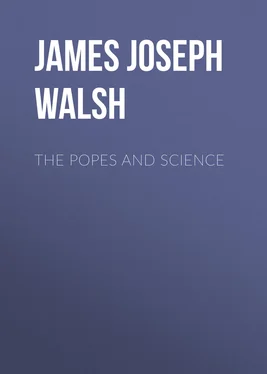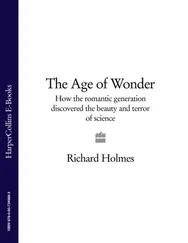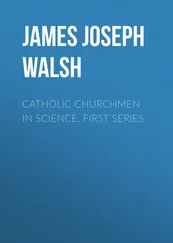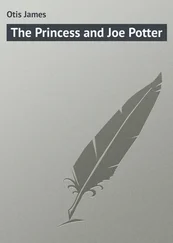James Walsh - The Popes and Science
Здесь есть возможность читать онлайн «James Walsh - The Popes and Science» — ознакомительный отрывок электронной книги совершенно бесплатно, а после прочтения отрывка купить полную версию. В некоторых случаях можно слушать аудио, скачать через торрент в формате fb2 и присутствует краткое содержание. Жанр: foreign_prose, foreign_religion, foreign_antique, на английском языке. Описание произведения, (предисловие) а так же отзывы посетителей доступны на портале библиотеки ЛибКат.
- Название:The Popes and Science
- Автор:
- Жанр:
- Год:неизвестен
- ISBN:нет данных
- Рейтинг книги:4 / 5. Голосов: 1
-
Избранное:Добавить в избранное
- Отзывы:
-
Ваша оценка:
- 80
- 1
- 2
- 3
- 4
- 5
The Popes and Science: краткое содержание, описание и аннотация
Предлагаем к чтению аннотацию, описание, краткое содержание или предисловие (зависит от того, что написал сам автор книги «The Popes and Science»). Если вы не нашли необходимую информацию о книге — напишите в комментариях, мы постараемся отыскать её.
The Popes and Science — читать онлайн ознакомительный отрывок
Ниже представлен текст книги, разбитый по страницам. Система сохранения места последней прочитанной страницы, позволяет с удобством читать онлайн бесплатно книгу «The Popes and Science», без необходимости каждый раз заново искать на чём Вы остановились. Поставьте закладку, и сможете в любой момент перейти на страницу, на которой закончили чтение.
Интервал:
Закладка:
"The little book De abditis causis morborum (brief title), was not published in any form by Antony Benivieni himself, but posthumously by his brother Jerome, who found these precious notes in Antony's desk after his death, and with the hearty cooperation of a friend competent in the subject, published them in 1506 in a form which no doubt justly merits our admiration. Benivieni's chief fame for us is far more than all this; it is that he was the founder of pathological anatomy. So far as I know, he was the first to make the custom and to declare the need of necropsy to reveal what he called not exactly "the secret causes," but the hidden causes of diseases. Before Vesalius, before Eustachius, he opened the bodies of the dead as deliberately and clear-sightedly as any pathologist in the spacious time of Baillie, Bright and Addison. Virchow, in his address at Rome, said Morgagni was the first pathological anatomist who, instead of asking What is disease? asked Where is it?"
But Benivieni asked this question plainly before Morgagni: "Not only," says he, "must we observe the disease, but also with more diligence search out the seat of it." The precept is so important, I will quote the original words: "Oportet igitur medicum non solum morbum cognoscere, sed et locum in quo fit, diligentius perscrutari."
Among the pathological reports are morbus coxae (two cases); biliary calculus (two cases); abscess of the mesentery, thrombosis of the mesenteric vessels; stenosis of the intestine; some remarkable cardiac cases, several of "polypus" (clot, which was a will-of-the-wisp to the elder pathologists); scirrhus of the pylorus, and probably another case in the colon; ruptured bowel (two cases); caries of ribs with exposure of the heart. He gives a good description of senile gangrene which even Paré did not discriminate. He seems to have had remarkable success in obtaining necropsies; concerning one fatal case he says plaintively, "Sed nescio qua superstitione versi negantibus cognatis," etc. Of another he says, "cadavere publicae utilitatis gratia inciso" (the case of cancer of the stomach). With this admirable and original leader, Italian medicine of the fifteenth century closes gloriously, to slumber for some fifty years, till the dayspring of the new learning. Of his work Malpighi says, and apparently with truth, "up to now it is the only work in pathology which owes nothing to anyone."
This should be enough, it seems to me, to settle the question that anatomy was permitted very freely before Versalius's time. I have said it in other places, but it may be well to recall here, that Berengar did his dissection at Bologna just before and after the time it became a Papal city and when Papal influence was very strong. In spite of the fact that in 1512 Bologna passed under the dominion of the Popes, there is no question of any interruption or hampering of Berengar's work in anatomy, and as a matter of fact, this great anatomist did not succeed to the professorship of anatomy, which had been held up to this time by Achillini, until in the very year when Bologna came under Papal sway, and had his opportunity to do his independent work only after this. Professor Turner can scarcely find words strong enough to set down his admiration for Berengar and his work. Besides what we have already quoted he says that, "the science of anatomy boasts in Berengar of one of its most distinguished founders."
The distinguished Edinburgh anatomist harbors no illusions with regard to any supposed opposition of the Church to dissection or to the development of anatomy. As a life-long student of anatomy who knew the history of his favorite science, he appreciated very well just who had been the great workers in it and where their work had been done. He says that "Italy long retained the distinction of giving birth to the first eminent anatomists in Europe, and the glory she acquired in the names of Mondino, Achillini, Berengar of Carpi, and Massa was destined to become more conspicuous in the labors of Columbus, Fallopius and Eustachius." These are the greatest names in the history of anatomy down to the beginning of the seventeenth century, with the single exception of Vesalius.
All this of anatomical development in Italy at universities that were directly under the ecclesiastical authorities would seem to settle all question of interference by the Popes or the Church with any phase of anatomical development. It does not seem sufficient for Dr. White, however. When I called attention to all these details of the history of anatomy, long before the reformation and before Vesalius, Dr. White's response was the following paragraph in which he explains how dissection came to be practiced at all, and reiterates not only his belief that Pope Boniface's bull prevented dissection, but even insists on what cannot but seem utterly absurd to any one who has read even the brief account I have given here, that except at one or two places, and then only to a very limited degree, dissection was not practiced at all. Here is how the history of dissection must be viewed according to Dr. White:–
"But Dr. Walsh elsewhere falls back on the fact that shortly after the decree of Pope Boniface VIII., which struck so severe a blow at dissection, the Venetian Senate passed a decree ordaining that a dissection of the human body should be made every year in the city of Venice, and he leaves his readers to conclude that this effectually proves that dissection had not really been discouraged by the Pope. The very opposite conclusion would be deduced by anyone familiar with the relations between the Republic of Venice and the Papacy. These two powers were always struggling against each other; again and again the Venetian Republic, in maintaining its rights, braved the Papal interdicts. The fact that it allowed dissections, so far from proving that the Pope allowed them, would seem to prove that in this case, and in so many other cases, and especially that of Vesalius of Padua, the Venetian Senate sought to show the Vatican that it would yield none of its rights to clerical control. This very fact–that Venice refused to be bound with regard to anatomical investigation by an order from the Vatican–seems to be entirely in the line with all the other facts in the case, which show that the Roman court had committed itself, most unfortunately, against the main means of progress in anatomy and medicine."
Here then is the answer that a modern historian and educator makes to all the representations with regard to the development of anatomy and the practice of dissection during the Middle Ages. If the practice of dissection was permitted it was in spite of the Popes. The fact that there were a dozen of medical schools in Italy at which dissection was carried on is ignored. The great anatomists of the fourteenth and fifteenth centuries simply did not exist–Dr. White knows nothing about them. There must be no admission that the Popes permitted dissection or any other form of science. Dr. White makes his last stand by a really marvelous tour d'esprit. It was Venice defying the Vatican that permitted dissection. This, he supposes, may help him, for anatomy did develop very wonderfully at Padua when it was Venetian territory. But, as pointed out by Roth, dissection was practiced very successfully, and the anatomical tradition established at Padua, before it came under the dominion of Venice. At all the other important cities of Italy dissection was carried on. We have given some of the evidence for Verona, for Pisa, for Naples, for Bologna, for Florence, and, be it remembered, even for Rome. Padua was the rival of Bologna in anatomy only for a comparatively short time. Bologna always maintained a primacy in the field of anatomy, and never more so than after she became a Papal city at the beginning of the sixteenth century. Vesalius taught and demonstrated not at Padua alone, but also at Bologna and at Pisa. For two centuries Rome was the most successful rival of Bologna, and hundreds of dissections were done in the Papal Medical School .
Читать дальшеИнтервал:
Закладка:
Похожие книги на «The Popes and Science»
Представляем Вашему вниманию похожие книги на «The Popes and Science» списком для выбора. Мы отобрали схожую по названию и смыслу литературу в надежде предоставить читателям больше вариантов отыскать новые, интересные, ещё непрочитанные произведения.
Обсуждение, отзывы о книге «The Popes and Science» и просто собственные мнения читателей. Оставьте ваши комментарии, напишите, что Вы думаете о произведении, его смысле или главных героях. Укажите что конкретно понравилось, а что нет, и почему Вы так считаете.












